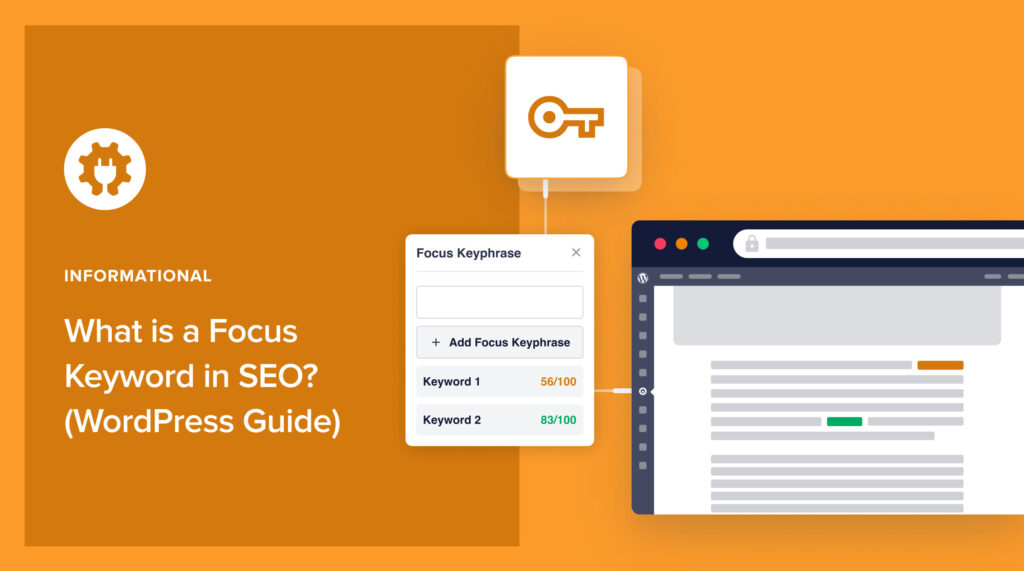Understanding what a focus keyword is, and how to use it well, is the first step in creating content that ranks.
This is why focus keywords are at the core of SEO strategy and content marketing.
In this article, you’ll learn what a focus keyword is, how to choose one, and how to use it so your content ranks well.
Let’s start with a definition.
In This Article
What is a Focus Keyword?
A focus keyword is the main topic of your web page and the search term you’re aiming to rank for.
Search terms, or keywords, are what users type into Google to find information.
A search term (or “search query”) can be a single word or a phrase.
It’s common for people to say “I want my website to rank on page #1 of Google.” But only single web pages rank. And they rank in relation to a keyword.
For example, we have an article that ranks #1 in Google Search for the keyword “WordPress multilingual SEO.”
Terminology: WordPress tutorials commonly use “focus keyword” or “focus keyphrase” interchangeably. But “keyword” or “target keyword” is also widely used. Focus keywords are also sometimes called primary keywords or keyword phrases.
Importance of a Focus Keyword
Choosing a keyword you want to rank for, before you create the related content, and optimizing your page for that keyword, is crucial for ranking well.
This is taking an intentional approach to SEO. It’s the opposite of hoping you’ll rank for something.
In the early days of the web, when there were only 3,000 or so web pages, people could write (and blog) without much planning and still be found.
Now, with over 1 billion websites online, you must take into account how Google sorts and ranks content.
 Infographic courtesy of Statista
Infographic courtesy of Statista
How to Optimize Your Focus Keyword Use
The easiest way to optimize your content for SEO is to use an SEO plugin.
We recommend All in One SEO (AIOSEO). This is an established plugin with thousands of 5-star reviews on WordPress.org. Currently, over 3 million people are using the plugin.
All in One SEO will analyze your focus keyword use and provide recommendations for improvement.

Let’s see how it works.
Step 1: Download and Install All in One SEO (AIOSEO)
The first step is to download and install All in One SEO.
A setup wizard will walk you through a few steps.
With All in One SEO installed, you’re ready to start optimizing.
Step 2: Open the AIOSEO Sidebar
While you’re logged into WordPress, navigate to a page you want to analyze.
Click the AIOSEO button at the upper right. That will open the AIOSEO sidebar.
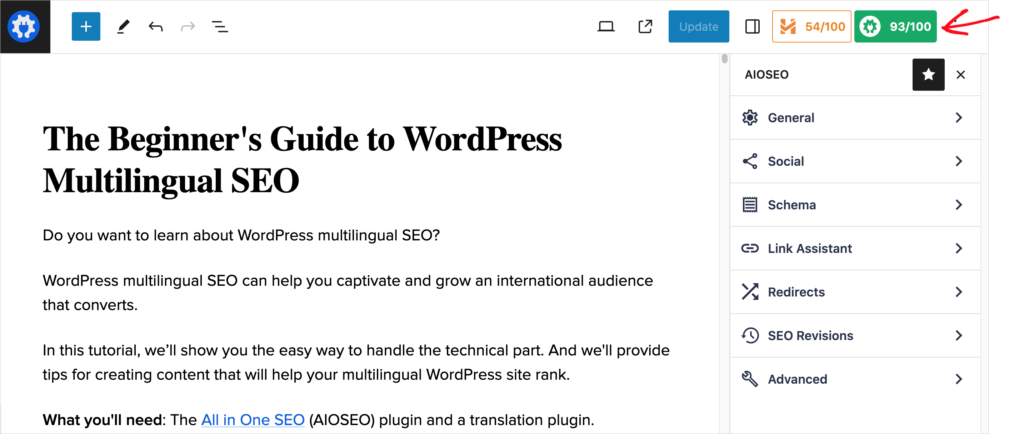
For this tutorial, we’ll use an article we created called “The Beginner’s Guide to WordPress Multilingual SEO.”
Step 3: Analyze Focus Keyword Use
Next, click General on the AIOSEO sidebar.
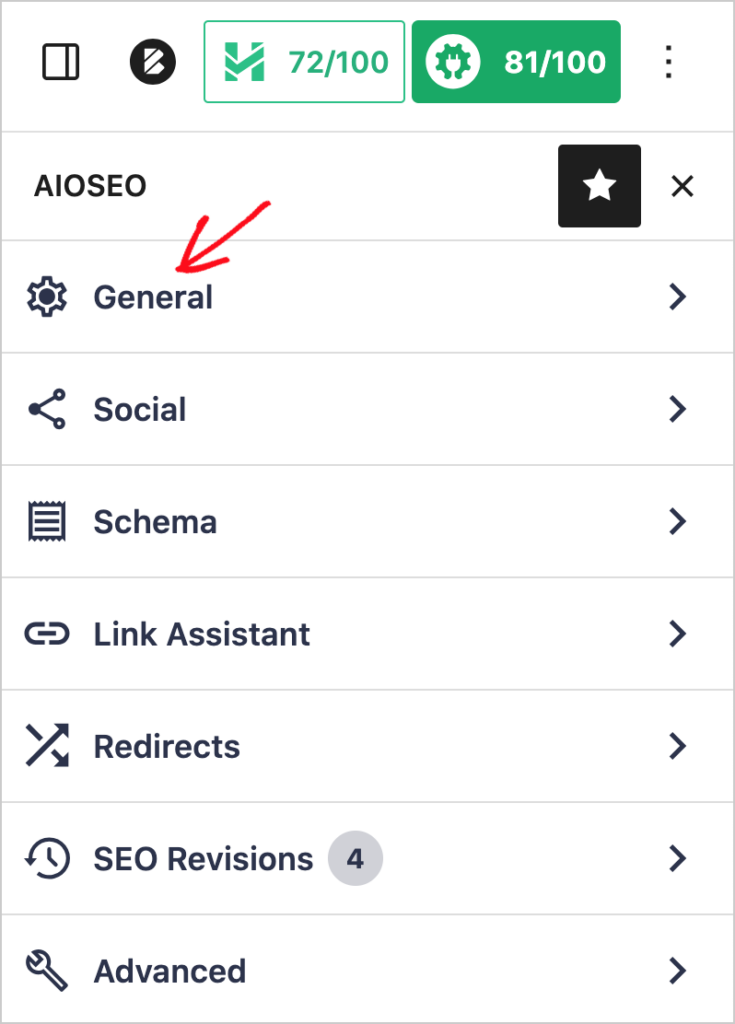
Then, scroll down and select Focus Keyphrase.

Now, enter your focus keyword into the blank field that appears. And click the Add Focus Keyphrase button.
For our example, we’ll enter our focus keyword: “wordpress multilingual seo.”
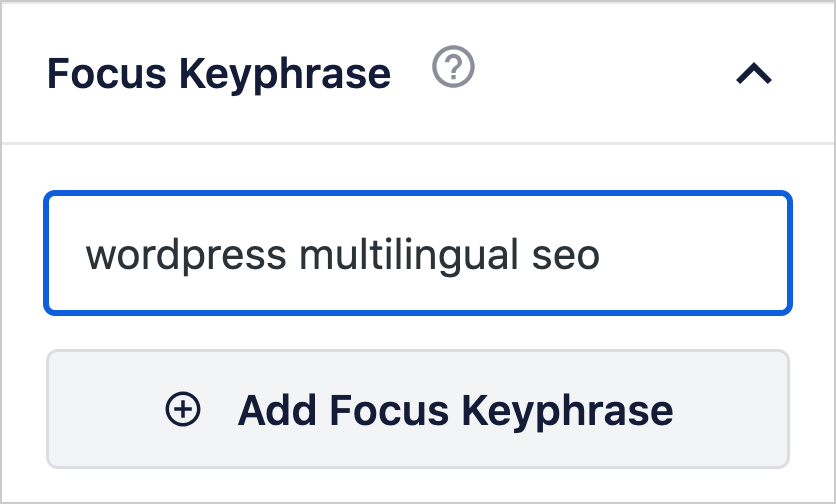
All in One SEO will check for the presence of your focus keyphrase in the following areas.
- Title tag and meta description
- First paragraph
- Page URL
- Subheadings
- Image alt text
If your focus keyword is missing from these areas, you’ll be prompted to add it.
Note: AIOSEO will expect to see your focus keyword in some subheadings and at least 1 image alt text.
Subheadings and Keyword Density: In addition to checking your subheadings for presence of your focus keyword, AIOSEO also checks keyword density. The purpose of this density check is to see if you’ve used your focus keyword enough so that the main topic is clear to users and search engines.
Use your judgment when assessing the plugin’s recommendations for subheadings and keyword density. If you feel like adding the focus keyword to more subheadings or adding most instances of it to the text will make the page sound awkward, then skip it.
We act on most (but not all) of the focus keyphrase recommendations.
So, how are we doing? Let’s return to the AIOSEO sidebar to see what our focus keyphrase score is.
Step 4: Review Your Focus Keyword Score
Here we see that our focus keyphrase score is 69/100.

We can see what we did well.
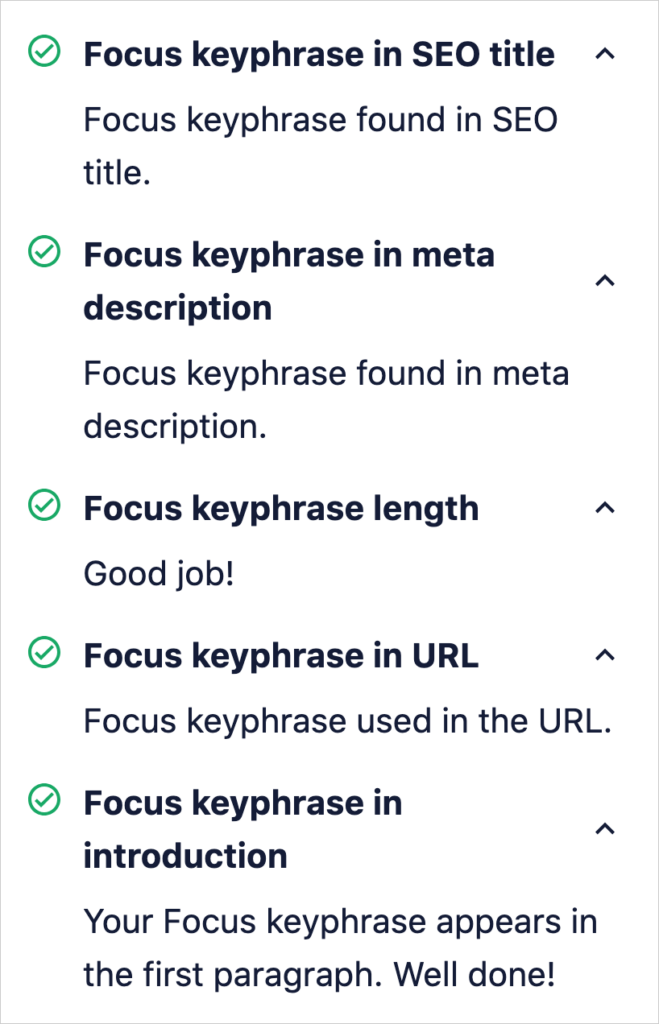
And we see the recommendations that we didn’t act on.

Our focus keyword “WordPress multilingual SEO” is a bit clunky sounding. We felt that adding it to more subheadings or to the text wouldn’t benefit the reader so we skipped those recommendations.
And we didn’t feel that any of our images warranted an alt tag that used our focus keyword. So, we skipped that recommendation, too.
Next, we’ll check AIOSEO’s other recommendations for our article.
Remember to avoid keyword stuffing. This outdated black hat SEO technique harms, rather than helps, SEO.
Step 5: Basic SEO and Readability
To fully optimize your page, return to the AIOSEO sidebar.
Click on Basic SEO, Readability, and Title.
Follow the instructions for improving these items. As you do so, you’ll see your overall SEO score, displayed at top right of the sidebar, go up.
Step 6: Check Your SEO Score
Our overall SEO score is 93/100 even though our focus keyphrase score is still 69/100. (The focus keyphrase score contributes to the overall SEO score.)

Our goal isn’t to get 100/100. It’s to improve our page from where we started.
Often 70 or above is very good.
Keep in mind that the SEO score in AIOSEO is an approximate measure of how your page SEO has improved.
These scores are not from Google.
Optimizing page content is also called “on-page SEO.”
Step 7: Review Your Ranking Results
So how did our article rank for its focus keyword?
Eight months after it was published our article on WordPress multilingual SEO landed the #1 slot on page 1 of Google results, out of 1.4 million results.

Rankings aren’t permanent of course, but once you’re solidly in the #1 position, your ranking may last for months, as ours has.
Content decay, or loss of ranking, is natural. Set aside some time once a year to improve your top pages, in order to maintain or boost your rankings.
Now that you know how to use a focus keyword, how do you go about choosing one?
This is where keyword research comes in.
Keyword Research: How to Choose a Focus Keyword
Instead of looking for the right focus keyword we can use principles to find the best keywords for our goals.
Here are some guiding principles to keep in mind.
1. Pick Keywords that are Easy To Rank For
Keyword research tools like Semrush and Ahrefs assign a keyword difficulty score to each keyword.
This makes it easy to find keywords that are easy to rank for.
In addition, Semrush’s click-button Keyword Magic Tool generates hundreds or even thousands of related keywords that are easier to rank for.
Learn more in Keyword Difficulty in SEO.
2. Check Keyword Intent
These keyword research tools also label keywords according to search intent. Add a keyword to Semrush and you’ll see its intent label.
- I is for Informational
- N is for Navigational
- C is for Commercial
- T is for Transactional
As you probably guessed, commercial and transactional keywords indicate the searcher has some buying intent.
They might be comparing products and prices (“Commercial”) or they may be on the brink of buying (“Transactional”).
As a small business, we focus on commercial and transactional keywords that are easy to rank for because they generate more revenue and take fewer resources to create content on.
We also produce some content on “Informational” keywords, but prefer to focus on keywords with buyer intent.
3. Consider Search Volume
Keyword research tools also display the estimated monthly search volume for each keyword. This means how many people search for that topic.
So once you’ve found some keywords that are easy to rank for you can prioritize the one’s you’ll write on by considering both the keyword intent and search volume.
Lastly, let’s clear up the difference between “long-tail keywords” and “short-tail keywords.” Is one type better than the other?
Long-Tail vs. Short-Tail Keywords
A short-tail keyword is a broad topic, while a long-tail keyword is more specific.
Take a look at these keywords. Which one is a short-tail (vague)? Which one is a long-tail?
- Flooring
- Wood flooring
- Exotic wood flooring
- Brazilian teak hardwood flooring
The 1st 2 keywords are broad. If you owned a flooring store, and someone walked in asking for “flooring” or “wood flooring” it’d be hard to know exactly what they wanted.
By contrast, if someone walked in and asked “Do you have exotic wood flooring?” you’d have a good idea of what they’re looking for.
And if they specifically asked for “Brazilian teak hardwood flooring” you’d know exactly what they wanted.
So why does this short-tail, long-tail stuff matter?
The more specific a keyword is, often, it’s also easier to rank for.
Here are Semrush’s Keyword Difficulty scores for the 4 keyword examples we mentioned. And notice: they all signal commercial intent.
| Keyword | Keyword Difficulty score | Keyword Intent |
|---|---|---|
| flooring | 90% – “Very hard” | Commercial |
| Wood flooring | 71% – “Hard” | Commercial |
| Exotic wood flooring | 15% – “Easy” | Commercial |
| Brazilian teak hardwood flooring | 11% – “Very easy” | Commercial |
Q&A on Focus Keyword Use
What are “Additional Keyphrases” in All in One SEO (AIOSEO)?
Below the field where you enter your focus keyword, there’s an optional field for “additional keyphrases.” Users may opt to add a secondary keyword that they want to rank for. And AIOSEO will include that in its analysis.
As an example, imagine we want an article to rank for “SEO benefits of sitemaps” and “SEO and sitemaps.” In this case we could enter both keywords.
Also realize that articles often rank for more than one keyword, even if those rankings were not intentionally targeted.
How do I find out how a web page is ranking in Google?
To find the ranking position of a web page it’s best to use a keyword research tool like Semrush, Ahrefs, or Ubersuggest.
For example, in Semrush, click on Keyword Overview and enter the keyword you wanted your web page to rank for. If your page is ranking in the top 100 results, you’ll see its exact position.
Why can’t I just do a Google search to see how my page is ranking?
Doing a Google search to determine how a web page is ranking isn’t ideal because Google personalizes its search results. For instance, if you have a Google account and use Chrome, Chrome remembers pages you’ve previously visited and may weight those higher in your personal search results.
To discover the absolute ranking of a web page, it’s best to use a keyword research tool like Semrush or Ahrefs.
How many times should you use the focus keyword in your text?
There’s no set number of times to use a focus keyword in text. SEO plugins may use formulas to measure “keyword density.” This is a proxy for using your keyword enough that the main topic is clear to the reader.
What’s the difference between a title and an SEO title?
A title usually refers to the title, or headline, of a page. In WordPress, an SEO title is the title that you want displayed in search results. Using a plugin like All in One SEO (AIOSEO), you can make the SEO title different from the page title. This means you can have one title showing up in search results, and a different one (for example, a shorter one) on your page.
After Focus Keywords . . .
Now that you know what focus keywords are and what their role is in content marketing is, what’s next?
Learn the basics of SEO. Then discover how to create scannable content that converts.
If you have a small business, explore the SEO secrets that pros use to grow revenue and consider creating topic clusters. And don’t forget to plan for conversions.
Come join us on our YouTube Channel to find simple WordPress search engine optimization tutorials. You can also follow us on X (Twitter), LinkedIn, or Facebook to stay in the loop.
Disclosure: Our content is reader-supported. This means if you click on some of our links, then we may earn a commission. We only recommend products that we believe will add value to our readers.
